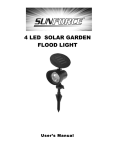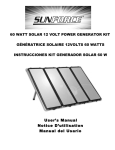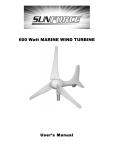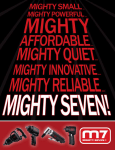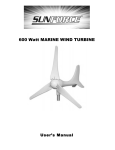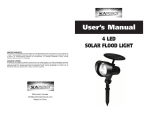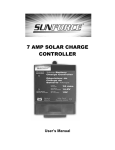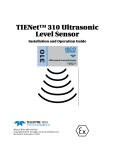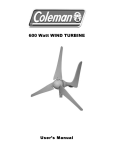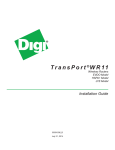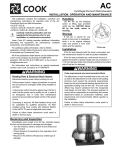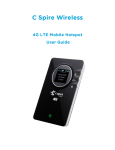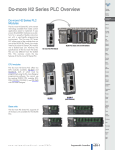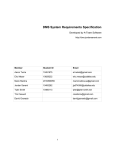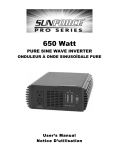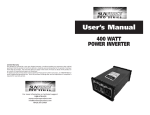Download o INSIDE BRACE SERVICE DOOR ONLY 70"L x 35"W x 70
Transcript
Edited by Foxit PDF Editor Copyright (c) by Foxit Software Company, 2004 For Evaluation Only. DOWNBLAST DIRECT DRIVE FAN REMOTE TERMINAL UNIT DIGI WR20 or M10 ENTRANCE DOOR OPENING WIDTH 25" OPTIONS SHOWN 70"L x 35"W x 70"H ENTRANCE DOOR PLC CONTROL UNIT SERVICE DOOR ONLY GEN RUN LED CHARGE CONTROLLER#1 CHARGE CONTROLLER#2 INSIDE BRACE Wireless Receiver o ENTRANCE DOOR FailSafe Closed Battery Box Options: AGM Battery NiFe Battery Battery Monitor PLC CONTROL UNIT TO CONTROL REMOTE STARTING OF GENERATOR DURING WEEKLY ROUTINE RUN AND EMERGENCY FOR BACKUP,PLC CONTROL UNIT CAN BE USED TO CONTROL TRAFFIC USING BASIC TIME CONFIGURATION Must Plug In Power Monitor To Generator To Allow Plc Unit To Confirm Run Condition. ENTRANCE DOOR o 12VDC 9WLED o 12VDC 9WLED LOUVERED VENTS FRONT AND BACK INSECT SCREEN ONLY Aluminum Back Panel For Rain/Snow Deflection o Component Mounting o Cord Storage Area Back Exit Can Be Configured In 7-8 Panel Bolt Together Design EXHAUST BAFFLE Cable Or Conduit Exit HOOKUP FOR METAL FLEX PIPE ENTRANCE DOOR o DDAR AXIAL DOWNBLAST DIRECT DRIVE FANS Air Volume: 2 - 2400 cfm Maximum SP: 1.5" wg. @ standard air density Axial Direct Drive Fans are the perfect low cost exhaust choice in the areas that have little or no ductwork, and thus, relatively low to moderate resistance. FEATURES & BENEFITS Spun aluminum housing for rust-free weather resistant durability Propellers constructed with die formed blades riveted to a steel hub Can be roof or wall mounted Standard bird screen Wire conduit to provide a clear channel for electrical connections Emergency Disconnect Switch OPTIONS Gravity Damper. Motorized Damper. Wall Mount Sleave. Roof Curb. CERTIFICATIONS FloAire certifies that Model DDAR10 thru DDAR18 shown herein are licensed to bear the AMCA seal. The ratings shown are based on tests and procedures performed in accordance with AMCA Publication 211 and comply with the requirements of the AMCA Certified Rating Program. Models DDAR10 thru DDAR18 are ETL Listed under file number 3049729-002 and comply with UL705 (electrical) Standards and CSA Std C22.2, No 113. Catalog #109F March 2009 Edited by Foxit PDF Editor Copyright (c) by Foxit Software Company, 2004 For Evaluation Only. Digi TransPort® WR21 Compact Enterprise Class Cellular Router Compact, flexible, low-cost enterprise 2.5G/3G/4G cellular router for remote and mobile networking applications. Overview Digi TransPort WR21 is a full-featured cellular router offering the flexibility to scale from basic connectivity applications to enterprise class routing and security solutions. With its highperformance architecture, Digi TransPort WR21 provides primary and backup connectivity and is designed for Wide Area Network connectivity including 2.5G/3G/4G networks and beyond. Optional Gobi™ module provides true HSPA+/EV-DO carrier diversity in a single solution. Application Highlight Electrical Substation Flexible power and connectivity options, along with extended temperature ranges make Digi TransPort WR21 a versatile product for both commercial and industrial environments. Digi TransPort WR21 is available in both standard routing and enterprise configurations. The standard version offers basic routing, NAT and security, while the enterprise version adds advanced routing, security/VPN and stateful firewall. Advanced features allow the Digi TransPort WR21 to be used as a component of a PCI compliant network. Digi management solutions provide easy setup, configuration and maintenance of large installations of remote Digi TransPort devices. iDigi® Manager Pro™ offers web-based device management for remote Digi cellular routers and gateways. Also available is the windows based Digi Remote Manager™ for customer installed device management and reporting. ® Digi Digi Di igi TransPort T TransPort ransP P t® WR21 WR21 Utility Headquarters Cellular Backup Cellular/ VPN 1 R2 tW or sP Digi an Tr WWA POW SIM SIM 1 2 SER ER SCADA Application Server NAL SIG N VICE Ethernet Ethernet SCADA Application Router Primary Connection Remote Cellular Backup Application Features/Benefits • Compact, low-cost, flexible cellular routing platform with standard and enterprise feature sets • Standard option includes basic routing and IP filtering; Enterprise option includes advanced routing protocols, VPN and stateful firewall Related Products • High-performance architecture, flexible power and extended operating temperature • 2.5G/3G/4G cellular interface including: including LTE, GSM:EDGE, HSPA, HSPA+ and CDMA: 1xRTT, EV-DO • RS-232 serial and 10/100 Ethernet or RS-232/422/485 serial and 2-port Ethernet switch VPN Concentrators Digi Remote Management Accessories • Digi remote management software solutions (including the iDigi® Device Cloud™ service) provide easy setup, configuration and maintenance of large installations www.digi.com Specifications Digi TransPort® WR21 Wireless Interfaces WWAN** GSM/CDMA Gobi (U8) GSM and CDMA supported on the same module via Gobi diversity; UMTS/HSPA/HSPA+ (850/900/1700 AWS/1800/1900/2100 MHz with Rx Diversity); EV-DO Rev A (800/1900 MHz with Rx Diversity); Transfer rate (max): 5.76 Mbps Up, 14.4 Mbps Down LTE - Verizon (coming soon) (L2) 700 MHz, Verizon LTE; Fall back to CDMA 850/1900 MHz; Transfer rate (max): 50 Mbps up, 100 Mbps down LTE - AT&T (coming soon) (L3) 700 MHz / AWS, GSM LTE; 3G fall back to HSPA 850/AWS/1900/2100 MHz; 2G fallback to 850/900/1800/1900 MHz; Transfer rate (max): 50 Mbps up, 100 Mbps down Edge (E1) CDMA 450 (Cx) CDMA 1xRTT (Bx) Connectors SIM Slots SIM Security GPRS/EDGE Class 10; 850/900/1800/1900 MHz; Transfer rate (max): 236 Kbps up/down 450 MHz; R-UIM support; Transfer rate (max): 1.8 Mbps up, 3.1 Mbps down 800/1900 MHz; Transfer rate (max): 153Kbps up/down U8, L2, & L3 variants: 2 x 50 Ω SMA (Center pin: female); E1, Cx, Bx variants: 1 x 50 Ω SMA (Center pin: female) 2 Optional SIM slot cover plate Other Additional Features Send GPS via UDP/IP, TCP/IP (up to two destinations) or serial; Customize and/or send data using Python; GPS status query; Time source capable Wired Interfaces Serial Ports Standard Async/Sync DTE/DCE Signal Support Flow Control COM Port Redirector Connector 1 Option of RS-232 or RS-232/422/485 Async DCE TXD, RXD, RTS, CTS, DTR, DCD, DSR, RI Software (XON/XOFF), Hardware supported RealPort® DB-9 Ethernet Ports Standard Physical Layer Data Rate Mode Option of 1 or 2 IEEE 802.3 10/100 Base-T 10/100 Mbit/s Full or Half duplex Interface Auto MDI/MDIX Connector RJ-45 USB Ports Option of 1 or 2 Standard USB 2.0 Signaling High-speed Connector Type A Other I/O N/A DSL N/A Software/Management Remote Management Local Management Management/ Troubleshooting Tools Software Packages Memory iDigi® Manager Pro™ (cloud based); Digi Remote Manager™ (user installed/managed); SNMP v1/v2c/v3 (user installed/managed) Web interface (HTTP/HTTPS); CLI (Telnet, SSH, SMS, Serial Port) FTP, SFTP, SCP; Protocol analyzer with PCAP for Wireshark; Event logging with Syslog and SMTP; NTP/SNTP Option of Standard or Enterprise. See next page for details. 128 MB NAND Flash/128 MB DDR2 SDRAM * Optional hardware ** Transfer rates are theoretical and network operator dependent *** Reduced cellular performance may occur above +60° C. Standard temperature power supplies may reduce temperature range. Specifications Digi TransPort® WR21 Power Input 9-30 VDC Consumption Connector 6W max, 4W typical Depending on model: Locking barrel or screw-down removeable terminal block DC Power Cord* DC Power Supply* Locking barrel to bare wire 100-240 VAC 50/60 Hz; Option of standard temperature or extended temperature Battery Backup None Physical Dimensions (L x W x H) 3.9 in x 5.2 in x 1.3 in (100 mm x 131 mm x 32 mm) Weight 1.08 lb (0.49 kg) Status LEDs Power, Service, WWAN, 3x Signal strength Enclosure Material/Rating Industrial (Metal)/ IP50 Mounting Brackets for wall mount & DIN rail sold separately Environmental Operating Temperature *** -35° C to +75° C Storage Temperature -40° C to +85° C Relative Humidity 20% to 95% (non-condensing) Ethernet Isolation 1.5 kV RMS Serial Port Protection (ESD) 15 kV Hazardous (Class 1 Div 2) Optional Conformal Coating N/A Approvals GSM/UMTS PTCRB, NAPRD.03, GCF-CC, R&TTE, EN 301 511 CDMA/EV-DO CDG TIA/EIA-690, CDG TIA/EIA-98-E Cellular Carriers Certified by most major carriers. Safety UL 60950, CSA 22.2 No. 60950, EN60950 Emissions/Immunity CE, FCC Part 15 Class B, AS/NZS CISPR 22, EN55024, EN55022 Class B Industry N/A Warranty Product Warranty Software Packages 5 years Enterprise Standard Same as Standard plus iDigi; Dynamic DNS client compatible with BIND9/No-IP/DynDNS HTTP, HTTPS, FTP, SFTP, SSL, SMTP, iDigi SNMP, SNMP (v1/v2c/v3), SSH, Telnet and CLI for web management; remote management via software tool (option); SMS management, protocol analyzer, ability to capture PCAP for use with Wireshark; DynDNS Security/VPN Stateful inspection firewall with scripting, address and port translation; VPN: IPSec with IKEv1, IKEv2, NAT Traversal; SSL, SSLv2, SSLv3, FIPS 197, Open VPN client and server; PPTP, L2TP; VPN Tunnels: 5 included. Additional available: WR21 (5 max.), WR41 (50 max.), WR44/WR44R/WR44RR (200 max.; Cryptology: SHA-1, MD5, RSA; Encryption: DES, 3DES and AES up to 256-bit; Authentication: RADIUS, TACACS+, SCEP for X.509 certificates; Content Filtering (via 3rd party); MAC Address Filtering; VLAN support; Ethernet Port IP filtering Routing/Failover IP pass-through; NAT, NAPT with IP Port Forwarding; Ethernet Bridging; GRE; Multicast Routing;Routing Protocols: PPP, PPPoE, RIP (v1, v2) OSPF, SRI, BGP, iGMP routing (multicast); IPv6 (firmware upgradable); RSTP (Rapid Spanning Tree Protocol); IP Failover: VRRP, VRRP+TM; Automatic failover/ failback to second GSM network/Standby APN IP pass-through NAT, NAPT with IP Port Forwarding Other Protocols DHCP; Dynamic DNS client compatible with BIND9/No-IP/DynDNS; QoS via TOS/DSCP/WRED DHCP; Dynamic DNS client compatible with BIND9/No-IP/DynDNS RealPort®; Modbus UDP/TCP to serial; X.25 including XOT, SNA/IP, TPAD and PAD; Protocol switch* RealPort® Protocols Specialty/Legacy Protocols * Optional hardware ** Transfer rates are theoretical and network operator dependent *** Reduced cellular performance may occur above +60° C. Standard temperature power supplies may reduce temperature range. Device Management Features • View of all remote devices and their connection status • Device statistic and report generation • Automatic registration of newly connected devices • Alarm generation and alerting • Remote device configuration • Secure access to all devices from web browser, anywhere • Actions include device grouping and scheduling of operations • Remote reboot of device and default reset • Monitoring of user specified events • Remote device management with iDigi Manager Pro, a Digi-hosted device management software Easy Remote Configuration and Management Customer Application Servers iDigi® Manager Pro™ need new Digi TransPort® WR Digi Gateway WAN ort X4 ctP nne Co Cellular Link Link Ethernet Serial Remote Device Remote Device Line Art Digi TransPort WR21 Visit www.digi.com for part numbers. 91001738 B1/113 DIGI SERVICE AND SUPPORT - You can purchase with confidence knowing that Digi is here to support you with expert technical support and a strong five-year warranty. www.digi.com/support Digi International Worldwide HQ 877-912-3444 952-912-3444 Digi International France +33-1-55-61-98-98 www.digi.fr Digi International Japan +81-3-5428-0261 www.digi-intl.co.jp Digi International India +91-80-4287-9887 Digi International Singapore +65-6213-5380 © 2011 - 2012 Digi International Inc. All rights reserved. Digi, Digi International, the Digi logo, Digi TransPort, RealPort, Digi Remote Manager, iDigi, iDigi Device Cloud and iDigi Manager Pro are trademarks or registered trademarks of Digi International Inc. in the United States and other countries worldwide. All other trademarks are the property of their respective owners. All information provided is subject to change without notice. Digi International China +86-21-5150-6898 www.digi.cn BUY ONLINE • www.digi.com [email protected] Edited by Foxit PDF Editor Copyright (c) by Foxit Software Company, 2004 For Evaluation Only. Digi m10™ Compact Satellite Modem Small footprint satellite modem with global satellite connectivity is designed for a wide variety of asset tracking and remote device communication applications. Overview The Digi m10 satellite module provides worldwide satellite data connectivity for a wide variety of asset-tracking and industrial remote communication applications. Operating on the ORBCOMM low-earth orbit (LEO) satellite network, it is designed to enable cost-efficient Machine-toMachine (M2M) communication with virtually unlimited global coverage and no blockage. All at a typical low monthly cost comparable to cellular plans for low data volume M2M applications. Application Highlight Satellite ta Da D at a Digi m10™ Storage Tanks m sa Built on Digi’s own patented mixed signal chip designed and tailored for satellite applications, the Digi m10 modem offers immediate product design integration through its integrated serial interface. With full support for industrial temperature and operational shock/vibration specifications exceeding SAE J1455, it is the ideal choice for reliable and highly cost-efficient satellite connectivity in even the most demanding application. The Digi m10 kits provide all necessary components for quick and easy product evaluation, development and prototyping. Target Applications AI ted 009M tec N: pro TAUs patent tel 10 lit a e d ! The FCC ta pro mo hib de its the Earth Station/ Control Center m use raft of this dev ice on airc NG RNI WA Link E F Internet Fluid Level Maintenance Alerts Operational Status Headquarters Features/Benefits • Cost-efficient with leading performance • Global LEO satellite coverage (no blockage) • Extremely compact module form factor • Highly integrated using Digi satellite technology • Very low transmit and receive power Utilities Industrial Automation Remote Device Management • Industrial operating temperature • Highly shock and vibration resistant • Quick and simple product design integration • Direct PCB mount or cable connection Transportation Security www.digi.com Do-more H2 Series PLC Overview Company Information Systems Overview Programmable Controllers Do-more H2 Series PLC Modules The Do-more H2 Series PLC is the newest technology available that makes control applications easier to implement. It uses proven DirectLOGIC hardware as a platform for a powerful, flexible instruction set, with a user-friendly programming environment. The Do-more H2 Series PLC utilizes most of the modules that are part of the DL205 PLC family. You simply install a Do-more H2 Series CPU module into a DL205 base unit. However, the specifications of the Do-more H2 Series PLC are very different from the DL205 PLC. This overview covers the key features of the Do-more H2 Series PLC. Field I/O Software C-more & other HMI Drives Soft Starters Motors & Gearbox DL205 PLC base unit and I/O modules Do-more H2 CPU Module Steppers/ Servos Motor Controls Proximity Sensors Photo Sensors CPU modules Limit Switches The Do-more H2 Series PLC offers two CPU modules available, H2-DM1 and H2-DM1E, both of which must be programmed using the Do-more Designer programming software. You cannot use the existing DL205 CPU modules (D2230, D2-240, D2-250(-1) and D2-260) with Do-more Designer. Encoders Current Sensors Pressure Sensors Temperature Sensors Pushbuttons/ Lights Process H2-DM1 H2-DM1E (with Ethernet) Relays/ Timers Comm. Terminal Blocks & Wiring Base units The Do-more H2 Series PLC supports all of the base units available for the DL205 PLC. Power Circuit Protection Enclosures Tools Pneumatics Appendix Product Index Part # Index Volume 14 w w w. a u t o m a t i o n d i r e c t . c o m / PA C s Programmable Controllers e38-1 Do-more H2 Series PLC Overview Discrete I/O modules The Do-more H2 Series PLC supports all of the discrete I/O modules available for the DL205 PLC. Analog I/O modules The Do-more H2 Series PLC supports all of the analog I/O modules available for the DL205 PLC. Volume 14 e38-2 Programmable Controllers 1 - 80 0 - 633 - 0405 Do-more H2 Series PLC Overview Company Information Systems Overview Programmable Controllers Specialty modules The Do-more H2 Series PLC supports many of the specialty modules available for the DL205 PLC. The following modules are supported: Field I/O Software C-more & other HMI Drives Soft Starters H2-ECOM100 H2-SERIO H2-SERIO-4 H2-ERM H2-CTRIO H2-CTRIO2 Motors & Gearbox F2-08SIM Steppers/ Servos Motor Controls Specialty modules NOT supported Proximity Sensors The following modules are NOT supported by the Do-more H2 Series PLC. Photo Sensors Limit Switches Encoders Current Sensors D2-DCM D2-RMSM D2-CTRINT F2-CP128 D2-EM D2-CM D2-RSSS Pressure Sensors Temperature Sensors Pushbuttons/ Lights Process DV-1000 Relays/ Timers D2-HPP Comm. Terminal Blocks & Wiring Programming Software Power The Do-more H2 Series PLC can only be programmed by Do-more Designer. (DirectSOFT programming software is not compatible with Domore PLCs) Circuit Protection Enclosures Tools Pneumatics Appendix Product Index Part # Index Volume 14 w w w. a u t o m a t i o n d i r e c t . c o m / PA C s Programmable Controllers e38-3 Do-more H2 Series PLC Overview Module Compatibility The following table shows which DL205 components are supported by the H2-DM1 and H2-DM1E Do-more CPUs. Module Base Units Module Compatibility Table Status Module Part Number D2-03B-1 F2-04AD-1 D2-04B-1 F2-04AD-2 D2-06B-1 F2-08AD-1 D2-09B-1 F2-08AD-2 D2-03BDC1-1 F2-04RTD D2-04BDC1-1 F2-04THM D2-06BDC1-1 Status F2-02DA-1(L) Analog I/O Modules D2-09BDC1-1 F2-02DA-2(L) D2-06BDC2-1 F2-02DAS-1 D2-09BDC2-1 F2-02DAS-2 D2-08ND3 F2-08DA-1 D2-16ND3-2 F2-08DA-2 D2-32ND3 F2-4AD2DA D2-32ND3-2 F2-8AD4DA-1 D2-08NA-1 F2-8AD4DA-2 D2-08NA-2 Local Expansion D2-CM Modules D2-EM D2-16NA Discrete I/O Modules Part Number No No D2-04TD1 H2-ERM D2-08TD1 H2-ERM-F D2-08TD2 D2-RMSM No D2-16TD1-2 D2-RSSS No D2-16TD2-2 H2-ECOM100 F2-16TD1P H2-ECOM-F F2-16TD2P D2-DCM D2-32TD1 H2-EBC100 Specialty Modules D2-32TD2 H2-EBC-F D2-08TA H2-SERIO F2-08TA H2-SERIO-4 D2-12TA F2-CP128 D2-04TRS H2-CTRIO D2-08TR H2-CTRIO2 F2-08TR D2-CTRINT F2-08TRS F2-08SIM Programmer Operator Interface D2-12TR D2-08CDR = Supported No No No D2-HPP No DV-1000 No No = Not Supported Volume 14 e38-4 Programmable Controllers 1 - 80 0 - 633 - 0405 Do-more H2 Series PLC Overview Company Information Systems Overview Programmable Controllers Communications The Do-more H2 Series PLC supports many communication protocols. The following table shows which CPU module communications port or specialty module supports each protocol. Field I/O Software CPU Modules Protocols Do-more Designer Programming H2-DM1 / H2-DM1E RS-232 USB Port Serial Port Yes Yes C-more & other HMI Specialty Modules H2-DM1E H2-ECOM H2-SERIO H2-ERM Ethernet H2-ECOM100 H2-ECOM-F H2-SERIO-4 H2-ERM-F Port Yes Yes Drives Soft Starters Yes Modbus/RTU Client (Master) Yes Yes Modbus/RTU Server (Slave) Yes Yes Motors & Gearbox Steppers/ Servos Modbus/TCP Client (Master) Yes Yes Motor Controls Modbus/TCP Server (Slave) Yes Yes Proximity Sensors DirectLOGIC RX/WX Client (Master) Yes Yes Yes DirectLOGIC RX/WX Server (Slave) Yes Yes Yes Yes Yes Yes Yes K-Sequence Server (Slave) Yes Photo Sensors Limit Switches Yes Encoders DirectNET Server (Slave) Current Sensors HEI Ethernet Remote I/O Master Yes SMTP (EMail) Client w/Authentication Simple Network Time Protocol (SNTP) Client Pressure Sensors Yes Yes Temperature Sensors Do-more/PEERLINK Yes Pushbuttons/ Lights Do-more Time Synchronization Protocol (Client, Server, Alternate Client) Yes Do-more Logger/UDP Yes Process Relays/ Timers Comm. Serial ad-hoc ASCII/Binary Programatic Control Yes Yes UDP ad-hoc Programmatic Control Yes TCP Client Programmatic Control Yes TCP Server Programmatic Control Yes Terminal Blocks & Wiring Power Circuit Protection Enclosures Blank = Not Supported Tools Pneumatics Appendix Product Index Part # Index Volume 14 w w w. a u t o m a t i o n d i r e c t . c o m / PA C s Programmable Controllers e38-5 Do-more H2 Series PLC Overview Do-more Designer (Part No. DM-PGMSW) Do-more Designer is the full-featured programming software for the Do-more PLC series. Do-more Designer is a free download from Automationdirect.com. A CD-ROM version is also available for purchase. Start Page When the software is started, the Start Page is displayed. This page contains a Launchpad with Projects, Applications and Links windows. It also contains shortcuts to important help file topics and the Do-more Simulator. Launchpad Help File Shortcuts Main Programming Window Project Toolbar The Main Programming Window is displayed when a new program is started or an existing program is opened. It is divided into Menus, Toolbars, and Windows that work together to make project development as simple as possible. Project Browser Ladder View Ladder Palette Bar Volume 14 e38-6 Programmable Controllers 1 - 80 0 - 633 - 0405 Do-more H2 Series PLC Overview Company Information Systems Overview Programmable Controllers Do-more Designer Features Do-more Designer has the following main features: Field I/O • Supports the Do-more PLC instruction set • Project Browser (Window to organize the user project) • Data View (Interface to monitor PLC data in a list) • Trend View (Interface to monitor PLC data with trend graphs) • PID View (Interface to monitor and tune the individual PID control loop) • PID Overview (Interface to monitor multiple PID control loops) • Debug View (Interface to debug the ladder programs) Software C-more & other HMI Drives Soft Starters When Do-more Designer is installed on your PC, the following tools are also installed: Motors & Gearbox • Do-more Simulator (Offline simulator of ladder program execution and PID control) • Do-more Logger (Software tool to log PLC data) • ERM Workbench (Configuration tool for the ERM modules) • NetEdit 3 (Configuration tool for the ECOM/EBC Ethernet modules) Steppers/ Servos Motor Controls PC Requirements Proximity Sensors The Do-more Designer Windows-based programming software works with Windows® XP (Home or Professional, 32-bit), Vista (Home, Basic, Premium, 32 or 64-bit) or Windows 7 (Home, Professional, Ultimate, 32 or 64-bit). Please check the following requirements when choosing your PC configuration: Photo Sensors Limit Switches • Minimum PC to PLC Connectivity, at least one of the following: - USB Port: connects to the CPU with USB-A connector (USB-A to USB-B cable) - RS-232 Serial Port: connects to the CPU with RJ-12 connector (RJ-12 to DB9 or RJ-12 to USB-B serial converter cable) - Ethernet Port: connects to the CPU (H2-DM1E) with RJ-45 10Base-T or 100Base-T (Cat5 Patch Cable) • Hard Disk: 100MB free disk space • Video Display: 1024x768, 256 colors resolution (1280x720, true color recommended) • Windows XP, 32-bit: - 800MHz, single core CPU (2GHz, multi-core or hyperthreaded recommended) - 512MB RAM (2GB recommended) • Vista or Windows 7, 32 or 64-bit: - 1GHz, single core CPU (2GHz, multi-core recommended) - 1GB RAM (3GB recommended) Encoders Current Sensors Pressure Sensors Temperature Sensors Pushbuttons/ Lights Process Relays/ Timers Comm. Programming Cables Terminal Blocks & Wiring The Do-more H2 Series CPU module H2-DM1 has two communication ports (USB and RS-232 serial) and the H2-DM1E has three communication ports (USB, RS-232 serial and Ethernet). You can use any of those ports for programming and monitoring. Needed cables for these ports are listed below and can be purchased at Automationdirect.com. Power Circuit Protection USB Cables (USB 2.0, Type A-B connectors) available: Enclosures • USB-CBL-AB3 (3 ft.) • USB-CBL-AB6 (6 ft.) • USB-CBL-AB10 (10 ft.) • USB-CBL-AB15 (15 ft.) Tools Pneumatics Appendix RS232 Serial Cable Product Index • D2-DSCBL (12 ft. 9-pin D-sub to RJ12 connector) Ethernet Cables (Cat5e) Part # Index Automationdirect.com sells many Ethernet patch cables in various colors and lengths. Please check the Cables section in this catalog for further details. Volume 14 w w w. a u t o m a t i o n d i r e c t . c o m / PA C s Programmable Controllers e38-7 Do-more H2 Series PLC Overview Do-more PLC Instruction Set This Instruction Set was developed specifically for the new Do-more PLC; the ‘Instruction Palette’ displays all available instructions. You may see some similarities to the DirectLOGIC PLC instruction set. However, the instruction set for the Do-more PLC is more advanced and intuitive. A good example is the MATH instruction. Now, just one MATH instruction covers all math operations and also allows you to mix different data types in one expression. There are over 60 operators and functions available with the MATH instruction. Note: To learn more about the MATH instruction, please refer to the Do-more Designer help topic ‘MATH – Math Expression’. Operators +, -, *, /, %, **, <, <=, ==, !=, >=, >, &&, ||, &, |, ^, <<, >>, >>>, -, ~, ! Funcons ABS, ACOS, ASIN, ATAN, AVGR, COS, COUNTIFEQ, COUNTIFNE, COUNTIFGE, COUNTIFGT, COUNTIFLE, COUNTIFLT, DEG, E, FRAC, IF, LN, LOG, MAXR, MAX, MINR, MIN, NOW, PI, RAD, RANDINT, RANDREAL, REF, ROUND, SIN, SQRT, STDEVR, STDEVPR, SUMIFEQ, SUMIFNE, SUMIFGE, SUMIFGT, SUMIFLE, SUMIFLT, SUMR, TAN, TICKms, TICKus, TOINT, TOREAL, TRUNC Volume 14 e38-8 Programmable Controllers 1 - 80 0 - 633 - 0405 Do-more H2 Series PLC Overview Company Information Systems Overview Programmable Controllers Data Types The Do-more PLC supports the following seven primary data types: Field I/O • Bit (0 or 1) • Unsigned Byte (0 to 255) • Signed Byte (-128 to 127) • Unsigned Word (0 to 65,535) • Signed Word (-32,768 to 32,767) • Signed DWord (-2,147,483,648 to 2,147,483,647) • Real (-3.4028235E+038 to 3.4028235E+038) Software C-more & other HMI Drives Soft Starters Note: As you can see, the BCD data type that is popular for the DirectLOGIC PLC is not included in this list. However, you can use the BCDTO and TOBCD instructions if you need to use the BCD data type with your application. Those instructions convert the data between the BCD data type and the integer/real data types. Motors & Gearbox Steppers/ Servos Data Structure Motor Controls The Do-more PLC supports data structures as additional data types. Structures use the familiar PC programming organization of “dot notation”. All available elements of a structure are shown in this format. The following data structures are currently available: Proximity Sensors Photo Sensors • Timer Structure • Counter Structure • String Structure • PID Structure • Date/Time Structure • Task Structure • Rampsoak Structure • Program Structure • DeviceRef Structure • Drum Structure Limit Switches Encoders Current Sensors Pressure Sensors The data structure is a set of data. For instance, a Timer structure (Timer Struct) has the following set of data: Temperature Sensors Pushbuttons/ Lights • Acc (Accumulated Time, Signed DWord) • Done (Bit) • Zero (Bit) • Timing (Bit) • Reset (Bit) Process Relays/ Timers When you use a timer instruction (TMR), a Timer structure is assigned to the instruction. If you select ‘T0’, you can access the above data with dot notation. For instance, to access the accumulated time (Acc), enter ‘T0.Acc’. To access the Done bit, enter ‘T0.Done’. Comm. Terminal Blocks & Wiring Memory Addressing Power With the Do-more PLC, each memory address type has its own specific data type. Here are some examples: Circuit Protection Enclosures • V (Unsigned Word) • N (Signed Word) • D (Signed DWord) • R (Real) Tools Pneumatics Appendix If you see address ‘V123’ in the ladder program, the memory address always stores an Unsigned Word value. With this memory addressing method, it becomes easier to read and write the ladder programs. Product Index Part # Index Although most of the memory addressing is decimal, the memory addresses DLX, DLY, DLC and DLV use octal. These four memory addresses can be used to exchange data with DirectLOGIC PLCs, which use octal memory addressing. Volume 14 w w w. a u t o m a t i o n d i r e c t . c o m / PA C s Programmable Controllers e38-9 Do-more H2 Series PLC Overview Array Addressing The Do-more PLC supports array addressing with all memory addresses. V-memory address must be used as the index for an array. With the Do-more PLC, the following ladder program is valid. Note: In this example, V0, V100, V101, V102 and V200 are indices. Code-block, Program and Task One Do-more project can consist of more than one ladder program. Each ladder program is called a ‘Code-block’. The Do-more PLC supports two types of code-blocks, Program and Task. Here are their definitions. Program Programs are code-blocks that run based on an event using the RUN instruction. They can be self-terminating or never terminate. Stage programming is only supported inside Program code-blocks. Task Tasks are code-blocks that are enabled and disabled using the ENTASK instruction. The ENTASK instruction allows you to specify an interval to execute the task’s logic with a millisecond resolution or to execute a single time on a leading edge input. Stages The Do-more PLC supports Stages. You can use Stages only in the Program code-blocks. (They are not available in the Task code-blocks.) The Do-more PLC supports the following instructions for Stage Programming1: • SG (SG) • JMP (Jump To Stage)2 • JMPI (Index Jump) • SGSET (Enable Stage) • SGRST (Disable Stage) • SGRSTR (Disable Range of Stages) • SGCONVRG (Converge Multiple Stages to SG) • SGDIVRG (Jump to Multiple Stages) 1 There is no ISG (Initial Stage) instruction for the Do-more PLC; the first stage in the Program code-block becomes the initial stage automatically. 2 Many asynchronous instructions can directly initiate a Jump to Stage. Volume 14 e38-10 Programmable Controllers 1 - 80 0 - 633 - 0405 Do-more H2 Series PLC Overview Company Information Systems Overview Programmable Controllers Comparison with the DL205 PLC The following spec table shows the major differences between the Do-more H2 Series PLC and the DL205 PLC. Field I/O Software C-more & other HMI Do-more H2 Series PLC DL205 PLC Do-more PLC instruction set DirectLOGIC PLC instruction set Drives 262.1K 30.4K Soft Starters BCD, HEX and Real Motors & Gearbox Octal Steppers/ Servos Yes No Motor Controls Bit of Memory Available for all memory addresses (e.g. V100.2, D200.3) Yes, D2-250(-1) and D2-260 only Array Addressing Available for all memory addresses (e.g. X[V100], Available only for V-memory addresses (e.g. P2000) D[V200]) Math Calculation No accumulator, the MATH instruction can support a Using accumulator or using the MATHBCD, MATHmix of different data types. BIN or MATHR instruction for each data type. Instruction Set Total Memory Bytes Default Data Type Memory Addressing Decimal and Real (Data can be referred in different data types with the ‘Casting’ feature.) Decimal mainly (There are some octal memory addresses to exchange data with DirectLOGIC PLCs easily.) User-defined Memory Addresses Number of Code Blocks Looping 1 system program 6 system tasks Up to 256 user programs Up to 256 user tasks FOR-NEXT, WHILE-WEND, REPEAT-UNTIL Subroutines User Document (Nicknames, Rung Comments…) Storing Proximity Sensors 1 Current Sensors FOR-NEXT Pressure Sensors Yes Stored in the CPU module No (Stored on PC only) Multiple passwords Single password Bumpless Ladder program execution is paused during the ladder program transfer in RUN mode. Run-time Editing Limit Switches Encoders No (Use Code-blocks) Password Protection Photo Sensors Temperature Sensors Pushbuttons/ Lights Process The X, WX and WY addresses are assigned to analog I/O channels automatically. (Manual addressing is available also.) Configured by ladder program Relays/ Timers Local Base Expansion No Yes (with D2-EM and D2-CM) Comm. Number of PID Loops Over 2000 4 (D2-250-1), 16 (D2-260) Terminal Blocks & Wiring Included Optional CPU module firmware can be updated from Do-more Designer. Use firmware update tool Yes, Full duplex Yes, Half duplex Yes No Yes (H2-DM1E) No Do-more Designer DirectSOFT Analog I/O Configuration Memory Back-up Battery Firmware Update Built-in RS-232 Port Built-in USB Port Built-in Ethernet Port Programming Software Power Circuit Protection Enclosures Tools Pneumatics Appendix Product Index Part # Index Volume 14 w w w. a u t o m a t i o n d i r e c t . c o m / PA C s Programmable Controllers e38-11 Dimensions and Installation Company Information Systems Overview Understanding the installation requirements for your Do-more H2 Series PLC system will help ensure that the components operate within their environmental and electrical limits. See the Enclosures section for an enclosure that may be suitable for your application 2" 50.8mm minimum Programmable Controllers Field I/O Software C-more & other HMI Plan for safety TERM RUN STOP 2"" 2 8 50.8mm m minimum USB PGM PORT This catalog should never be used as a replacement for the user manual. The user manual, H2-DM-M (sold separately or downloadable online), contains important safety information that must be followed. The system installation should comply with all appropriate electrical codes and standards. RS-232 SERIAL E 1 T 0 H / E 1 R 0 N 0 E T Drives Soft Starters 1.2" 30mm minimum Motors & Gearbox Steppers/ Servos Motor Controls Environmental specifications Proximity Sensors The Environmental Specifications table at the right lists specifications that apply globally to the Do-more H2 Series PLC system (CPUs, bases, and I/O modules). Be sure that the system is operated within these environmental specifications. Base dimensions and mounting Use the diagrams below to make sure the Do-more H2 Series PLC system can be installed in your application. To ensure proper airflow for cooling purposes, bases must be mounted horizontally. It is important to check these dimensions against the conditions required for your application. For example, it is recommended that approximately 3" of space is left in front PLC surface for ease of access and cable clearances. Also, check the installation guidelines for recommended cabinet clearances. Photo Sensors Limit Switches Environmental Specification Rating Storage Temperature Ambient Operating Temperature Ambient Humidity Vibration Resistance Shock Resistance Noise Immunity Atmosphere Base 3-slot 4-slot 6-slot 9-slot 12 or 16pt. I/O Encoders -4 F - 158 F (-20 C to 70 C) o o o o Current Sensors 32oF - 131oF (0oC to 55oC) 30%-95% relative humidity (non-condensing) Pressure Sensors MIL STD 810C, Method 514.2 MIL STD 810C, Method 516.2 Temperature Sensors NEMA (ICS3-304) No corrosive gases A (Base Total Width) Pushbuttons/ Lights B (Mounting Hole) C (Component Width) Inches Millimeters Inches Millimeters Inches Millimeters 6.77” 7.99” 10.43” 14.09” 172mm 203mm 265mm 358mm 163mm 194mm 256mm 349mm 148mm 179mm 241mm 334mm 6.41” 7.63” 10.07” 13.74” 5.8” 7.04” 9.48” 13.14” A 3.62” (92mm) 2.95” (75mm) C 4 or 8pt. I/O TERM ZL-D24-CBL40-X ZipLink cable RUN STOP USB PGM PORT RS-232 SERIAL TERM E 1 T 0 H / E 1 R 0 N 0 E T ZL-D24-CBL40 ZipLink cable Terminal Blocks & Wiring Power Enclosures Pneumatics 7.91" (201mm) D2-DSCBL-1 Approximate Dimension 5.85” (148mm) 3.62” (92mm) Volume 14 Programmable Controllers Appendix Product Index Airflow Ai fl w w w. a u t o m a t i o n d i r e c t . c o m / PA C s Comm. Tools B 4.76" (121mm) RUN USB PGM PORT RS-232 SERIAL H2-DM1E 2.99” (76mm) E 1 T 0 H / E 1 R 0 N 0 E T STOP OK Relays/ Timers Circuit Protection H2-DM1E 3.54” 90mm) Process e38-33 Part # Index 600 Watt MARINE WIND TURBINE User’s Manual Congratulations on your Sunforce Purchase. This product is designed to the highest technical specifications and standards. It will supply years of maintenance free use. Please read these instructions thoroughly prior to installation, then store in a safe place for future reference. If at any time you are unclear about this product, or require further assistance please do not hesitate to contact our trained professionals operating the customer support line 1-888-478-6435 or email to [email protected] The Sunforce 600 Watt Marine Wind Turbine is designed for watercrafts and any area in close proximity to salt water. The heavy-duty powder-coating adds enhanced resistance to the effects of the sun, wind, and water. All components have been tested to perform, without degradation under marine conditions. 1. SAFETY Your Sunforce 600 Watt Wind Turbine is designed with your personal safety as the first priority. However, there are still some inherent dangers involved with any electrical and/or mechanical equipment. Safety must be the primary concern as you plan the location, installation and operation of the turbine. Please read the following: Important Safety Instructions Please take the time to read through this manual prior to assembly. 1) Place this instruction manual in a safe place for reference. 2) Wait until a calm day to install or perform maintenance on your Turbine. 3) Listen to your Turbine should you hear any mechanical noise, maintenance may be required, please contact Sunforce Products Customer Service. 4) After installation re-adjust and tighten the screws and bolts. 5) Adhere to proper grounding techniques as established by the NEC. 6) Your Sunforce Wind Turbine must be installed in accordance with this manual and local and national building code. Incorrect installation may void your warranty. 7) Wind turbine blades spin at a potentially dangerous speed this must be respected. Never approach a turbine in motion. 8) Note wire size (gauge chart included) prior to wiring. Any under sizing of wire can be potentially dangerous. 1.1 Mechanical Hazard Rotating blades present the most serious mechanical hazard. The rotor blades are made of very strong thermoplastic. At the tip, the blades may be moving at velocities over 15m/s. At this speed, the 2 tip of a blade is nearly invisible and can cause serious injury. Under no circumstances should you install the turbine where a person could come in contact with moving rotor blades. 1.2 Electrical Hazard The 600W Turbine is equipped with sophisticated electronics designed to provide protection from electrical dangers. Please note that the inherent personal dangers from electrical current still exist, therefore caution should always be used when connecting this and other electrical devices. Heat in a wiring system is often a result of too much current flowing through an undersized wire or through a bad connection. Please consult wire guide table below. Choosing your Sunforce 600 Watt Wind Turbine’s location Prior to the mounting of your Sunforce 600 Watt Wind Turbine, you must carefully consider a location. Things to consider when thinking about your location: A) Distance from any obstacles that will cause turbulence, trees, buildings etc. B) Distance from MPPT controller and battery bank C) Any local zoning restrictions D) Clearance of power lines E) When mounting on a boat, be aware of moving objects that may obstruct the turbines blades. In general terms the higher the tower the less obstruction to air flow, leading to a more efficient charge capacity. The minimum recommended tower height is 30 ft or 20 ft above nearby obstructions for land installations as shown below. 3 2. MODEL AND SPECIFICATION TABLE 2.1 Specification Table Model 600W Marine Turbine Related speed 12.5 m/s (41 ft/s) Related power 600 W # Voltage with MPPT 12 or 24 V ## Rotor diameter 0.65 m (2.1 ft) Cut-in wind speed 4.5 MPH Survival wind speed 157 MPH Number of Blades 3 Blade material Fiber glass Suggested battery capacity >100 A/Hr 2.2 Performance specifications The following power curve shows the performance you should expect from your wind turbine. During smooth, steady wind speed, you can expect to see output resembling the curve illustrated below. To convert between power and current use the following formula: POWER = VOLTAGE × AMPS 3. Digital-controlled MPPT Wind Power Charger Please see included Manual for your MPPT Charge Controller. 4 MCU fully digital-controlled MPPT wind power charger. SEPIC conversion, large DC input voltage range. Smart load management function, braking function. Rated Output Power : 600W Max. Battery Voltage Range: 12V or 24V DC Input Voltage Range 5~75 Vrms Charger Efficiency: >87% Battery Protection Voltage: 12V - 14.4V(Lead-acid batteries) or 15.8V(deep-cycle Battery) 24V - 28.8V (Lead-acid batteries) or 30V (Deep-cycle batteries) Rated Load Current: 35A Max. Over-Speed Braking: ≦1400 rpm Caution: Please review the following wire gauge table to install the correct wire gauge. Sunforce recommends these as the minimum wire sizes for optimal performance. Always use the largest gauge wires that are practical and affordable. Local, state, and or national electrical codes take precedence over these general recommendations. 3.1 System wiring diagrams There are multiple options to connect your Wind Turbine dependant on your power requirements and available components. 5 Single Turbine installation: 6 Multiple Turbine installation: 7 Hybrid Solar/Wind System A typical “hybrid” system (Photovoltaic and Wind combined) is wired as follows Whenever feasible wire the turbine and solar panels to their own set of battery terminals. 8 4. PACKAGE CONTENTS Check the parts listed with the contents of the box and make sure that you have everything needed for assembly. Figure 1 Caution: The edges of the blades are sharp. Please handle with care. Name Quantity Turbine 1 Blades 3 MPPT Charge Controller 1 Hub 1 Vertical Tail 1 Nose Cone 1 Amp Meter 1 Nut (M14xP2.0) 1 Hex Screw(M6xL30) 6 Nut (M6) 6 Hex Screw (M5xL12) 1 9 Spring Washer (M14) 1 Stop Screw (M5xL20) 1 Hex Sleeve 1 Hex Key no.5 1 Hex Key No.3 1 Rubber Spacer 1 Hex Screw (M5xL20) 4 Washer (M5) 4 Nut (M14xP2.0) 1 Hex Screw (M6xL30) 6 Nut (M6) 6 Hex Screw (M5xL12) 1 Replacement Spring Washer (M14) 1 Screw Pack Rubber Spacer 1 Hex Screw (M5xL20) 4 Washer (M5) 4 Stop Screw (M5xL20) 1 Screw Pack 5. INSTALLATION PROCEDURE Step1: Open box to ensure all parts are present, remove the hub from the box. Figure 2 Step2: Take out the blades from box and fasten the blades on hub with nuts. 10 Figure 3 Figure 4 Caution: Make sure that all of the bolts are secured with nuts. Step 3: How to install the hub. Figure 5 Adhesive strip should be wrapped around your Tower (not included) to increase secure connection to the Yaw shaft. 11 Step 4: Take out the wind turbine from box and put the cables through the mast. Figure 6 Step 5: To install the wind turbine to your chosen tower (not included) securely fasten the bolt by using the hex wrench. Figure 7 Step 6: Install the hub on the wind turbine using M14 nut and spring washer. 12 Figure 8 Figure 9 Caution: Make sure the nut is secured with the spring washer. Step7: Put the sleeve inside the nose cone and fasten the nose cone to the hub. Apply pressure to the connections to ensure a secure fit. Figure 10 Figure 11 Figure 12 Step 8: Tail Fin assembly. Use the four supplied HEX screws, to firmly connect the Tail Fin to the hub. 13 Figure 13 6. MAINTENANCE Your Sunforce Products 600 Watt Wind Turbine has been designed to run for long periods without requiring any maintenance. Performance will be enhanced if you periodically inspect your system. Review the following simple maintenance procedures and implement every six months. Caution: Do not go near the wind turbine during operation. Caution: The blades are sharp. Please handle with care. • Check blades for superficial damage. Replace blades if damaged. It is important to not use blades that are damaged, as you will lose overall balance, resulting in a decrease in efficiency. Should you notice damage to the blades you must replace all 3. The blades are balanced as sets. • Check the blade bolts and the hub nut for tightness. • Check nosecone for cracks and tighten nuts. • Wipe any excess dirt build-up from the blades. • Check all electrical connections to make sure they are tight and free from corrosion. • Check the voltage of your battery bank with a Multi-meter and clean the terminals. • Sunforce Products suggests replacing the blades every five years for optimal performance. 7. FAQS (1) How does the Sunforce Products 600 Watt Wind Turbine control power and RPM in high winds? Your Turbine’s operation will be halted to reduce the risk of damage due to overcharge and over spin 14 of the rotor blades. This process of braking is handled internally through your Turbines electronics. (2) What is the maximum wind speed the Sunforce Products 600 Watt Wind Turbine will survive, and do I need to take it down in a storm? Your wind turbine is designed to operate in most climatic conditions. Should you expect or experience winds of 150MPH upwards, please turn off the MPPT controller which will in turn manually apply the braking system to protect from any over spin. Once the Turbine has stopped it is possible to lay down the Tower to offer further protection. (3) How long will the bearings or other wearing parts last? According to engineering calculations, the bearings should have a 10-year life span in 12- mph (6 m/s) average wind speed sites. Bearing life will vary from one application to another; however, you should expect at least a five-year performance in adverse conditions and 10 years in normal conditions. (4) Can the Sunforce Products 600 Watt Wind Turbine be connected in reverse-polarity to the battery without causing any damage? Reverse polarity will cause damage to both your MPPT controller and battery if not quickly remedied. Always double check any wiring to reduce the risk of reverse polarity. Your turbine is equipped with polarity protection to reduce the risk of damage, but it is still possible to degrade your wiring and cause damage to the overall system. (5) Will it hurt my Sunforce Products 600 Watt Wind Turbine to short-circuit the output? No, the Sunforce Products 600 Watt Wind Turbine is designed to be short-circuited as a normal shutdown procedure by a fuse. The function of the stop switch is to both disconnect the turbine from the batteries as well as short-circuit the output of the turbine. (6) Where can I locate tubing to make a tower? Your Sunforce Products 600 Watt Wind Turbine is designed to make mounting as simple and straightforward as possible. Should you not wish to purchase the custom tower kit feel free to utilize schedule 40 1.5 inch steel tubing. This should be available through your local hardware outlet. (7) What is the difference between copper and aluminum wire? Generally aluminum wire is less conductive, so it must be bigger for the same amp load and resistive losses as copper. Sunforce Products 600 Watt Wind Turbine uses copper or tinned copper for the yaw wires. (8) What battery should I choose for my Sunforce Products 600 Watt Wind Turbine? There are multiple battery options in today’s market– flooded lead acid, absorbed Glass mat (AGM), gel cell and NiCad. There is no definitive choice for your alternative energy needs. Normally the 15 choice of battery is determined by availability and pricing. Should you have questions regarding batteries please consult a local battery supplier. Or view: www.batterycouncil.org. The capacity of your battery bank is determined by your use. Below is a good guideline. • 12-volt systems – 400 Amp-hours • 24-volt systems – 200 Amp-hours (9) Is my Sunforce Products 600 Watt Wind Turbine protected from salt corrosion? Yes. All components have been rigorously tested to perform under marine conditions. Possible Battery Configurations (suggested) 16 (9) Is lightning protection necessary? You should ground your Sunforce Products 600 Watt Wind Turbine. Proper grounding (illustrated below) provides protection to individuals and equipment by eliminating the possibility of dangerous voltage. Remember a steel tower is a conduit for lightning. Every wind turbine and turbine tower needs to be grounded at the tower base even though the system may be grounded at the battery bank. Grounding the tower at its base may help prevent shocks to persons touching the tower due to lightning or electrical faults. Please take the time to review the National Electrical Code (NEC) and local building and zoning regulations for complete requirements. Even in “Off Grid Systems” There are multiple ways for tower grounding, the most common method is a copper clad steel electrode(s) driven into the soil. Please view the following grounding diagram. (10) What effect does radio interference have on my Sunforce Products 600 Watt Wind Turbine? The internal circuitry of the Sunforce Products 600 Watt Wind Turbine is shielded and filtered to prevent radio interference, and has been tested to insure electro-magnetic compatibility. (11) What effect does my Sunforce Products 600 Watt Wind Turbine have on radio transmissions? 17 The Sunforce Products 600 Watt Wind Turbine normally does not affect radio transmitters. Care should be taken, however, to route power lines from the Sunforce Products 600 Watt Wind Turbine away from the power and antenna lines of a radio transmitter. An old ham radio operator’s trick is to twist positive and negative wires together to provide an even distribution of EMF noise across both wires, which serves to cancel out the electrical noise created. This technique can be used on the Sunforce Products 600 Watt Wind Turbine power lines, on the radio’s power lines, and on transmission wires. Transmission lines should always be kept as far from power lines as is practically possible. Proper grounding of the Turbine and other system components must also be observed. (12) Will it affect the regulation of my Sunforce Products 600 Watt Wind Turbine to install an RF (radio frequency) filter? An RF filter should not affect the regulation of the Turbine, but any electronic devices placed in line with the turbine must be rated for the proper current and voltage. It is best to place any line filters on the power lines for the load device that requires it, and as close to the device as possible. Trouble shooting You may require an extra person to assist with these tests. 1) Remove the blade/hub from the turbine. Replace the rotor hub nut on the rotor shaft. 2) Quickly spin the rotor shaft manually with your fingers while connecting and disconnecting the red and black wires (turbine must not be connected to batteries). 3) With the red and black wires connected to each other, the shaft should be more difficult to turn. When the wires are disconnected it should spin freely. Should this not be true please contact supplier or Sunforce Products. 4) With your 600 Watt Wind Turbine connected to your battery bank, use an electric hand drill to spin the rotor shaft. 5) Below 500 RPM, the rotor should spin freely without friction. 6) At 500 RPM and above, the Wind Turbine should be charging the battery. You should feel resistance on the rotor shaft if the shaft is not rotating; contact your turbine dealer or Sunforce Products. Be aware your battery banks needs to be under 12V or 24V for this testing as the Turbine needs to read a charge. Warranty Sunforce Products warrants your product to be free from defects in material and/or workmanship for a period of 5 years from original date of purchase. Warranty coverage is extended only to customer (original purchaser). If product proves defective during warranty period, Sunforce Products, at its option will: 1. Replace wind turbine with new or refurbished product. 2. Correct reported problem Customers warranty continues to be valid on repaired or replaced product from original warranty date. 18 Restrictions This warranty covers defects in manufacturing discovered while using the product as recommended by the manufacturer. The warranty does not apply to a) equipments, materials, or supplies not manufactured by Sunforce Products. b) Product that has been modified or altered other than by Sunforce Products or without prior Sunforce Products approval. c) Has been exposed to winds exceeding 157mph d) Windstorms, lightning and Hail damage e) Repairs performed by other than authorized Sunforce Products support staff. f) All acts of God; misuse, negligence or accidents. g) Tower foundation and wire h) has not been installed, operated, repaired or maintained in accordance with the instructions supplied by manufacturer. Any service identified in the above list or product is found not to have any defect in manufacturers’ workmanship or materials the customer will be responsible for the costs of all repairs and expenses incurred by Sunforce Products. Disclaimer EXCEPT FOR THE EXPRESSED WARRANTY SET FORTH ABOVE, THE MANUFACTURER DISCLAIMS ALL OTHER EXPRESSED AND IMPLIED WARRANTIES, INCLUDING THE IMPLIED WARRANTIES OR FITNESS FOR A PARTICULAR PURPOSE, MERCHANTABILITY AND NON-INFRINGEMENT. NO OTHER WARRANTY, EXPRESSED OR IMPLIED, WHETHER OR NOT SIMILAR IN NATURE TO ANY OTHER WARRANTY PROVIDED HEREIN, SHALL EXIST WITH RESPECT TO THE PRODUCT SOLD UNDER THE PROVISIONS OF THESE TERMS AND CONDITIONS. THE MANUFACTURER EXPRESSLY DISCLAIMS ALL LIABILITY FOR BODILY INJURIES OR DEATH THAT MAY OCCUR, DIRECTLY OR INDIRECTLY, BY USE OF THE PRODUCT BY ANY PERSON. ALL OTHER WARRANTIES ARE EXPRESSLY WAIVED BY THE CUSTOMER. Warranty Claims & Return Policies To be eligible for service under this warranty, customer must either contact manufacturer either through written request or by telephone to submit a service request for the wind turbine covered by this warranty within specified period (5 years from original date of purchase) and request a return authorization (RA) number, This RA # must be issued before any product can be returned. All notifications must include the following information: a) Description of alleged defect b) How the wind turbine was being used c) Serial # d) The original purchase date e) Name, phone #, address of party requesting warranty Within 2 to 3 business days Sunforce Products will provide the customer with an RA# and will direct customer to location where the product is to be returned. Once an RA has been issued the customer has 30 days to return 19 the product. Failure to deliver the product within the 30 days results in the RA as no longer being valid and a new RA must be issued. Manufacturer is under no obligation to accept any product that is returned to them without a proper RA #. Limitation of Liability UNDER NO CIRCUMSTANCES WILL THE MANUFACTURER OR ITS AFFILIATES OR SUPPLIERS BE LIABLE OR RESPONSIBLE FOR ANY LOSS OF USE, INTERRUPTION OF BUSINESS, LOST PROFITS, LOST DATA, OR INDIRECT, SPECIAL, INCIDENTAL, OR CONSEQUENTIAL DAMAGES OF ANY KIND REGARDLESS OF THE FORM OF ACTION, WHETHER IN CONTRACT, TORT (INCLUDING NEGLIGENCE), STRICT LIABILITY OR OTHERWISE, RESULTING FROM THE DEFECT, REPAIR, REPLACEMENT, SHIPMENT OR OTHERWISE, EVEN IF THE MANUFACTURER OR ITS AFFILIATE OR SUPPLIER HAS BEEN ADVISED OF THE POSSIBILITY OF SUCH DAMAGE. (Note: some states and provinces do not allow the exclusion or limitation of incidental or consequential damages, so these limitations may not apply to you.) Neither the manufacturer nor its affiliates or suppliers will be held liable or responsible for any damage or loss to any items or products connected to, powered by or otherwise attached to the hardware. The total cumulative liability to Customer, from all causes of action and all theories of liability, will be limited to and will not exceed the purchase price of the Product paid by Customer. This warranty gives the Customer specific legal rights and the Customer may also have other legal rights that vary from state to state or province to province. For more information or technical support 1-888-478-6435 www.sunforceproducts.com [email protected] M600WE011711 20 MPPT Marine Charge Controller User’s Manual 1 Congratulations on your Sunforce Products purchase. This product is designed to the highest technical specifications and standards. It will supply years of maintenance free use. Please read these instructions thoroughly prior to installation, then store in a safe place for future reference. If at any time you are unclear about this product, or require further assistance please do not hesitate to contact our trained professionals operating the customer support line 1-888-478-6435 or email to [email protected] Introduction: Your Maximum Power Point Tracking (MPPT) charge controller enables the 600 watt marine turbine to achieve its highest possible performance by periodically tracking the Maximum Power Point of the turbine’s output. The MPPT can be used with battery systems of either 12v or 24v DC. This user guide will demonstrate the basic operation and troubleshooting of your MPPT charge controller. Features: Maximum Power Point Tracking technology. 12 / 24 Volt automatic detection system. Temperature-Compensated, Three-Stage Charge Regulation. Fully Waterproofed design Inline Fuse (40Amp) Manual/Automatic braking system Power Output: 450 Watt @ 12V (Max 450W) / 500 Watt @ 24V (Max 600W) Charge Voltage: 12V / 24V (auto detect) Input Voltage: 5~75 Volts AC Efficiency: >97-99% Battery Type: 12V/24Volt Wiring: Caution: for safety reasons before any wiring, please ensure that the manual brake is set to the “ON” position. The three output wires from wind turbine carry 3 phase AC current. These three wires need to be connected to the corresponding 3 wire configuration coming from the MPPT charger. Wires require clean water resistant connections. The secondary wire coming from the MPPT charger has two purposes. 1. Connection to either a 12 Volt or 24 Volt battery system 2 2. Connection directly to a 12/24 Volt load • Red, Positive (+) • Black, Negative (-) The included Amp meter can be wired in at this point, between MPPT and battery bank. The load connection wire is fused (40A). Should you not be utilizing this option, simply disconnect the fuse to block any risk of current transfer Reading your LED’s • Power on (Green). Illuminates when the turbine, MPPT, battery is connected. • Charging/Discharging (Green). Illuminates when turbine begins charging cycle. Under 12Volts the LED will ‘blink’. When Turbine is in brake mode or during prolonged periods of turbine inactivity the LED may blink to show a small Discharge from the battery. • Protection (Red). Illuminates when either the brake is manually activated, or internal safety mechanism is activated. Under manual braking the LED may blink. Notification: 1. Multiple function MPPT chargers will charge a battery and may also be connected to a DC to AC power inverter or a DC load. The current output passed by the terminal will also be managed by the MPPT. 2. Loose connections can cause a large voltage drop to occur which may result in damage to the wires and insulation. Always adhere to correct polarity. Double check before you activate your system. Damage caused by reverse polarity is not covered under the warranty. When connecting the positive (+) terminal to the 12 volt power source's positive (+) terminal, a spark may occur. This is a normal occurrence. Because of the possibility of this sparking, it is critical that both the turbine and the 12 / 24 volt battery be placed well away from any possible source of inflammable fumes and/or gases. 3. The charger is equipped with an auto brake function. However it is strongly suggested that the user turn on the manual brake in extreme weather conditions. 4. Check the battery health periodically. If the voltage of the battery is lower than 10Volt the charger will not work and the turbine will automatically lock. Important Safety Measures • • • For the most effective use, place the MPPT Controller on a flat surface. Refrain from moving the MPPT whilst in ‘Charging” state. All wire connections should be secure and sealed watertight. 3 Multi –Stage Battery Charging: The MPPT charge controller is a sophisticated multi-stage battery charger that uses several regulation stages to allow fast recharging of the battery system while ensuring a long battery life. This process can be used with both sealed and non-sealed batteries. The MPPT will automatically set the charging regulation voltage set points (absorb & float) for the selected nominal battery voltage. Troubleshooting Guide MPPT does not turn on (Green LED) 1. Check battery connection and polarity. Reverse polarity or improper connection will cause power-up issues. 2. Is the battery voltage greater than 10.5v? A battery voltage less than 10.5v will not power up the MPPT. MPPT not producing expected power 1. Are wind conditions optimal? The primary consideration in a wind generator is the average wind speed at the installation site. Wind turbines in locations with constantly high wind speeds bring best return on investment. 2. Are the batteries charged? Is the MPPT in the absorbing or float stage? If so, the MPPT will produce enough power to regulate the voltage at the absorption or float set point voltage, therefore, requiring less power in these modes. 3. Are you using the correct wire gauge? Please consult the wire chart in your 600 Watt Marine Turbine owner’s manual. Warranty: This product is covered under a five year limited warranty. Sunforce Products Inc. Warrants to the original purchaser that this product is free from defects in materials and workmanship for the period of five years from date of purchase. To obtain warranty service please contact Sunforce Products for further instructions, at 1 888 478-6435 or email [email protected] please note that proof of purchase including date, and expiration of compmaint is required for warranty service. For more information or technical support 1-888-478-6435 www.sunforceproducts.com [email protected] MMPPTE011711 4 Xtended Range from Linear Wireless that Goes the Distance Handheld Transmitters Linear’s Xtended Range wireless receivers and transmitters are more than twice as powerful, 6 times more sensitive, and 3 times more immune to interference than the next best mid-range wireless equipment. Handheld Transmitter Specifications Frequency: 27.255 MHz ± .0025% (center frequency) XT-1H Bandwidth: 6 KHz RF modulation: FSK ± 2 KHz nominal RF output impedance: 50 Ohm nominal Data encoding format: EMR Power output: 2 watts minimum Input voltage range: battery operated Input current: .5 Amp transmitting, less than 1 µA standby Reverse battery protection: yes Batteries: 2-9 Vdc batteries Antenna: 8-inch antenna (supplied) Loop response time: 500 ms Transmit time: 1 second Code transmissions: alarm and low battery Measured range: approximately 2 miles Programming inputs: System code select: two, eight-position DIP switches (16 bits, 65,536 codes) Rx channel select: two DIP switch positions Bank select: two DIP switch positions Buttons: tactile type Button debounce time: buttons must remain stable for 150 ms for a transmission to begin Indicators: one red LED lights when transmitter is pressed and flashes when power supply voltage falls below specified voltage Temperature range: -20° to +60°C (-4° to +140°F) Housing: grey, weather-resistant, high impact plastic Connectors: RF: BNC Size: 2.5 x 4.75 x 1.25 in (64 x 121 x 32 mm) Weight: 1 lb (0.454 kg) Regulatory: FCC Part 95, no license required XT-2H XT-4H USES: Construction Sites Golf Courses Stationary Transmitters Stationary Transmitter Specifications XT-1 1 Channel Transmitter XT-4 4 Channel Transmitter Marinas Frequency: 27.255 MHz ± .0025% (center frequency) Bandwidth: 6 KHz RF modulation: FSK ± 2 KHz nominal RF output impedance: 50 Ohm nominal Data encoding format: EMR Power output: 10 watts minimum Time out: built into the code format Input voltage range: 11 to 15 Vdc (13.5 Vdc nominal) Input current: 2 Amps maximum transmitting; 15 µA typical standby Input current protection: fused with reverse polarity protection Loop response time: 500 ms Transmit time: 1 second Code transmissions: alarm, restore, status, and low battery Status report time frame: 70 minutes Programming inputs: System code select: two, eight-position DIP switches (16 bits, 65,536 codes) Rx channel select (XT-1 only): two DIP switch positions Bank select: two DIP switch positions Status select: single DIP switch, ON-enabled, OFF-disabled Auto-restore select: single DIP switch, ON-enabled, OFF-disabled N/O, N/C select: XT-1: two-position jumper to select input type XT-4: four-position DIP switch to select input type Test button: internal; transmitter sends a status signal when test button is pressed (if pressed and held, transmitter times out after 30 ±3 seconds Indicators: one red LED lights when transmitter is pressed and flashes when power supply voltage falls below specified voltage; LED located underneath rear cover Temperature range: -4° to +140°F (-20° to +60°C) Housing: black, weather-resistant, anodized aluminum enclosure with removable end caps to provide wiring and programming access; end caps secured with screws Connectors: RF: SO-239 External input: XT-1: two-position screw terminals (input and ground) XT-4: eight-position screw terminals (input and ground per channel) Power supply input: two-position screw terminals (power and ground) Size: 4.25 x 6.25 x 2.5 in (108 x 159 x 64 mm) Weight: 1.0 lbs (0.454 kg) Regulatory: FCC Part 95, no license required Note: Requires ANT-2 antenna kit for proper operation Municipal Parks Farms and Stationary Receivers Frequency: 27.255 MHz ± .0025% (center frequency) RF modulation: FSK ± 2 KHz (nominal) RF input impedance: 50 Ohm nominal Receiver type: superheterodyne Data input: alarm, restore, status, and low battery Data decoding format: EMR Common outputs Status exception: one open collector output per receiver, 20 Vdc @ 50 mA maximum Status exception time frame: 4 hours Low battery: one open collector output per receiver, 20 Vdc @ 50 mA max Signal strength test point: buffered signal strength output (0 to 5 V) Common connectors RF: SO-239 Status and low battery: XR-1 and XR-4, two-position screw terminals (status and low battery); XR-16, three-position screw terminals (status, low battery, and ground) Power supply input: two-position screw terminals (power and ground) XR-1 1 Channel Receiver XR-4 4 Channel Receiver XR-16 16 Channel Receiver Size: 4.25 x 6.25 x 2.5 in (108 x 159 x 64 mm) Weight: 1 lb (0.454 kg) Current drain: XR-1: 25 mA, typical standby; 65 mA alarm @ 12 Vdc XR-4: 25 mA, typical standby; 185 mA alarm @ 12 Vdc Programming inputs: System code select: two, eight-position DIP switches (16 bits, 65,536 codes) Status select: XR-1: one DIP switch position, ON-enabled, OFF-disabled XR-4: four DIP switch positions (by channel), ON-enabled, OFF-disabled Channel select XR-1 only: two DIP switch positions, select channel 1, 2, 3, or 4 Additional outputs: Alarm: Form “C” relay per channel, 1 A @ 32 Vdc (N/O, N/C, and common) Additional connectors: Alarm output: XR-1: three-position screw terminals (N/O, N/C, and COM) XR-4: four sets of three-position screw terminals (N/O, N/C, and common) Indicators: one red LED lights when there is RF activity and one green Power On LED; LEDs visible when rear cover is on the unit Agriculture Sensitivity: -115 dBm (or better) Selectivity: 8 KHz Number of codes: 65,536 Code setting method: two, eight-position DIP switch programming Image rejection: 50 dB minimum Adjacent channel rejection: greater than 50 dB ± 9 KHz from Fc Input voltage range: 11 to 15 Vdc (13.5 Vdc nominal) Input current: reference specific receiver(s) Input current protection: reverse polarity protection Temperature range: -20° to +60°C (-4° to +140° F) Housing: black, weather-resistant, anodized aluminum enclosure with removable end caps to provide wiring and programming access, end caps secured with screws; window on XR-1 and XR-4 Test Jumpers: Audio output: test jumpers on the printed circuit board Signal strength output: test jumpers on the printed circuit board (0 to 5 V) Regulatory: FCC Part 95, no license required Note: Requires ANT-1A or ANT-2 antenna kit Size: 6.5 x 7.9 x 1.25 in (165 x 201 x 32 mm) Weight: 1.5 lbs (0.680 kg) Current drain: 300 mA maximum @ 12 Vdc Programming inputs: System code select: two, eight-position DIP switches (16 bits, 65,536 codes) Status select: two, eight-position DIP switches, one position per channel, ON-enabled, OFF-disabled Trouble disable: jumper—remove to disable, trouble output on channel and trouble output relay Additional outputs: 16 open collector: (20 Vdc @ 50 mA, maximum), field programmable for either N/O or N/C operation Channel and trouble output: form “C” relay, 1 A @ 32 Vdc (N/O, N/C, and common); this output is activated when any output is activated (channel, status, or low battery) Additional connectors: Channel and trouble output: three-position screw terminals (N/O, N/C, and common) Channel outputs: twenty-position screw terminals, 16 channel outputs, and four grounds Indicators: three, seven-segment displays; provides alarm, status, and low battery indication by channel; RF activity displayed by the decimal point Substations Storage Facilities When there’s nothing but 10 miles of bad road (or no road) between you and a remote site, Xtended Range gets you there. With the new Xtended Range family of products, we now offer one of the industry’s longest range wireless transmitterreceiver activation systems, giving you up to 10 miles line-ofsight. In the right terrain and system conditions you may even be able to transmit 15 miles or more*. Linear’s Xtended Range is the long-distance leader, beating nearly every comparable wireless transmission device on the market. Linear Means Power: Increased output capability from 4 watts to 10 watts minimum per channel, enabling more than double the operating range than the competition. Super Sensitivity: Crystal controlled, FM-based receivers operate in the CB band of frequencies at 27.255 MHz and offer sensitivity of -115 dBm or better. Interference Immunity: Highly selective Xtended Range uses FSK rather than AM modulation, so it won’t pick up stray signals. The absence of typical FM interference makes it a super-reliable long-distance link. Compact & Reliable: Advanced circuit technology packs maximum capability into minimum space, significantly boosting reliability. Fully Supervised: All Xtended Range products can perform automated checks to ensure that they are communicating properly – so you never have to worry about its status. The Xtended Range family offers hourly status reporting, low battery detection and reporting, and portal supervision for peace of mind. You also get field-selectable “Auto Restore” that triggers momentary receiver output when the transmitter input is activated. Feature Rich: The Xtended Range product family offers Form C NO/NC relays on receivers, and the transmitters have internal RF test button and transmission indicator giving you visual verification of activity. Receivers have both power and RF activity indication and RF signal audio output, making the system easy to setup and configure. Secure & Solid: Code clashes are unlikely as the Xtended Range has 64,000 available codes. Plus, receivers and transmitters are housed in time-tested weather-resistant cases with adjustable strain relief bushings to secure and shield wiring. No FCC Licensing: Xtended Range receivers and transmitters do not require FCC licensing or registration, further easing customer installations. Easy installation: Designed for quick setup and easy upgrades, DIP switches make system coding and mode changes fast, allowing for rapid addition or replacement of transmitters without having to visit the receiver and transmitter site. *We field-tested the Xtended Range at distances of 20 miles, and the signal showed no sign of quitting. Linear developed the Xtended Range suite of products with flexibility and variety in mind, so users can tailor long-distance links to their needs – remote monitoring, switching systems, networking, security, or remote control. Different models and channel combinations can be mixed and matched to accomplish your most sophisticated projects. Accessories ANT-1A 8-Inch Antenna (for applications under one mile; for use with XR Receivers only) T-1224DC Wall Mount Power Supply (recommended for XT transmitters) ANT-2 3-Foot Whip Antenna (for maximum range and difficult applications; required for XT-1, XT-4 Transmitters) T-124.8DC Wall Mount Power Supply (recommended for XR receivers) CON-90 Right Angle Antenna Connector for ANT-1A Ordering Information XT-1 Single-Channel Stationary Transmitter - Order number: SST00083 XT-4 Four-Channel Stationary Transmitter - Order number: SST00084 XT-1H Single-Channel Handheld Transmitter - Order number: SNT00395 XT-2H Two-Channel Handheld Transmitter - Order number: SNT00396 XT-4H Four-Channel Handheld Transmitter - Order number: SNT00397 XR-1 Single-Channel Stationary Receiver - Order number: SSR00068 (Form “C” alarm output) XR-4 Four-Channel Stationary Receiver - Order number: SSR00069 (Form “C” alarm output per channel) XR-16 16-Channel Stationary Receiver - Order number: SSR00066 (open collector alarm outputs) WARNING: These products should not be used in life safety applications. FCC Rules allow unlicensed high-power transmissions at or near the operating frequency of these products, which may interfere with, or even disable, normal operation of the radios. Specifications subject to change without notice. Linear LLC | 1950 Camino Vida Roble | Suite 150 | Carlsbad, CA 92008 | 800.421.1587 | www.linearcorp.com P/N215858E Edited by Foxit PDF Editor Copyright (c) by Foxit Software Company, 2004 For Evaluation Only. ® Features STD Series Multi-Wire Connectors • Available in 3A, 10A, 16A, 6B, 10B, 16B, 24B, and 32B sizes • Heavy-duty metal housings in polyester powder coated die-cast aluminum alloy or self-extinguishing thermoplastic housing • Single locking system (one lever locked on two pegs) or double locking system (two levers locked on four pegs) • Mechanical duration of 500 cycles • Operating temperatures from -40°C to 125°C (-40°F to 257°F) • IP66 degree of protection with enclosure when coupled • NEMA/UL Type 1, 4, 4X, 12 protection with enclosure when coupled. • Conforms with EN61984, VDE 0110, VDE 0627, EN 175301-801, and UL 1977, UL50, UL50E standards • UL and CE approvals Housings Hoods • Available with top entry and side entry cable passages • Standard and high-construction profiles • Threaded cable passages with Pg threads (EN 60423) with optional Pg to NPT adapters • Stainless steel or thermoplastic locking pegs • Accessories include cable glands and Pg thread to NPT adapters Hood Accessories Inserts Bases, Couplers and Covers • Surface and bulkhead mounted bases • Two cable passages on surface mount bases • Seal gaskets made of anti-aging, oil-resistant and fuel-resistant vinyl nitrile elastomer • Locking levers made of galvanized steel or self-extinguishing glass-filled thermoplastic; guarantees perfect closing and sealing Inserts • Self-extinguishing thermoplastic reinforced with glass fibers • Asymmetric guide rails prevent incorrect coupling • Captive installation screws allow for easy and secure installation to bases and hoods • Laser-printed or molded terminal/contact positions on both sides of insert • Copper alloy contacts with hard silver or gold plating available with stainless steel captive screw terminal or machined crimp contact • Wide contact surface for ground terminals • IP20 without enclosures • Suitable for stranded and solid conductors Base Accessories • A wide range of accessories including: - Pg to NPT adapters - Plugs with gaskets - Cable glands (IP66 & IP68) - DIN rail mounting kits - Crimp tools - Replacement screws, code pins and gaskets - Insert plates (with cutouts, reducers, blank) - Coding pins Agency Approvals • UL Recognized File number E342543 • CE • RoHS • NEMA 250 Volume 14 e29-120 Terminal Blocks and Wiring Solutions 1 - 80 0 - 633 - 0405 ® STD Series Multi-Wire Connectors General Characteristics Application Examples Size and Identification Field I/O Software C-more & other HMI Drives Soft Starters Motors & Gearbox Steppers/ Servos Inserts ZIPport multi-wire connectors require one male and one female insert. The inserts are available in multiple pole configurations from 3 poles plus ground up to 144 poles plus ground and with termination sizes ranging from 26 to 12 AWG, 10 to 80 Amps. Y Proximity Sensors Size 24B shown The size of each type of connector is determined by the distance between the center points of the four installation screws. These four points are common to both the insert and the housing. This is indicated by “X”-“Y” in the illustration above. The table below lists the size identification and the actual X-Y distance for each type of connector offered. Size 3A 10A 16A 6B 10B 16B 24B 32B The housings for the ZIPport multi-wire connectors consist of a hood that mates with a base or a coupler. They are made of die-cast aluminum with a polyester powder finish or from self-extinguishing thermoplastic and are suitable for use in industrial applications. A single or double lever locking system assures coupling stability and protection against accidental opening. The locking system is comprised of stainless steel or glass filled thermoplastic levers, with compatible interlocking pegs. Motor Controls X Photo Sensors Housings All housings are available in a standard profile. Several are offered with a high construction (HC) profile that allows more room for wiring the higher density inserts. Systems Overview Programmable Controllers • Electronic machinery • Robots • Control equipment • Power connections • Control and signal circuits • Packaging machinery • Theatrical applications • Industrial equipment • Electrical panels ZIPport inserts are made of UL 94 V-0 rated self-extinguishing thermoplastic resin rated at a maximum temperature of 125°C (257°F). The inserts are available in screw terminal and crimp style contact block connections. The contacts are copper alloy with a hard silver or gold plating. The plastic insulators are numbered on both sides by laser printing or molding in accordance with EN 60068-2-70. • Suitable for use with alternating (AC) or direct current (DC) • Leading protective ground • Polarized for correct mating • Interchangeable for male and female inserts in hoods and bases • Captive screws • Can be used with hoods and bases, or with rack and panel applications Company Information Limit Switches Encoders Current Sensors Pressure Sensors Temperature Sensors Pushbuttons/ Lights Process Distance X-Y Relays/ Timers 21 x 21 mm* [0.83 x 0.83 in] Comm. 49.5 x 16 mm [1.95 x 0.63 in] 66 x 16 mm [2.60 x 0.63 in] Terminal Blocks & Wiring 44 x 27 mm [1.73 x 1.06 in] 57 x 27 mm [2.24 x 1.06 in] Power 77.5 x 27 mm [3.05 x 1.06 in] Circuit Protection 104 x 27 mm [4.09 x 1.06 in] 77.5 x 62 mm [3.05 x 2.44 in] * The center distance cannot be given because the 3A inserts have only one screw: 21 x 21 indicates the size of the sectioned insert. Enclosures Tools Pneumatics Safety Appendix Product Index Volume 14 w w w. a u to m at i o n d i re c t . c o m / d i n n e c to rs Terminal Blocks and Wiring Solutions e29-121 Part # Index ® STD Series Multi-Wire Connectors Specifications Technical Characteristics Connector Size 3A Number of Poles 3+PE 4+PE 10A 5+PE 7+PE 12+PE UL/CSA Rated Voltage* 10A EN 61984 (2001- Rated Voltage AC/DC 11) Pollution Impulse Withstand Voltage Degree 3 16A 250V 230/400V 320/500V 230/400V 16A 10A 4kV 400/690V 230/400V 6kV 4kV 1010 액 Polycarbonate -40°C to 125°C (-40°F to 257°F) Flammability UL 94 V-0 GWT 960° With Housing IP66, NEMA/UL (Type 1, 4, 4x, 12) Without Housing IP20 Mechanical Working Life 500 Cycles Screw Terminals ✔ Crimp Contacts N/A ✔ N/A N/A N/A ✔ N/A ✔ N/A N/A ✔ ✔ ✔ ✔ ✔ ✔ ✔ Material Hard-silver plated (2µm Au) or gold plated copper alloy Min. Recommended Load (voltage & current) 5V/5mA AC/DC (silver plated) 울1 m액 Contact Resistance 울3 m액 울1 m액 울3 m액 울1 m액 울3 m액 mm ² 0.5-2.5 mm² N/A 0.5-2.5 mm² N/A 0.5-2.5 mm² N/A AWG 20-14 AWG N/A 20-14 AWG N/A 20-14 AWG N/A Screw Terminal Tightening Test Torque 0.5 Nm N/A 0.5 Nm N/A 0.5 Nm N/A Screw Terminal Stripping Length 7.0 mm N/A 7.0 mm N/A 7.0 mm N/A Crimp Terminal Wire Size mm ² N/A AWG N/A Crimp Terminal Stripping Length 0.5-2.5 mm² Locking Element 0.14-2.5 mm² 0.14-4.0 mm² 0.14-2.5 mm² 0.14-4.0 mm² 0.14-2.5 mm² 26-14 AWG N/A 7.5 mm Material 26-12 AWG 26-14 AWG 26-12 AWG 26-14 AWG N/A 7.5 mm N/A 7.5 mm N/A Glass filled polyamide Glass filled polyamide lever and peg Flammabilty Housings Seal Degree of Protection Acc. to EN 60529 (coupled) Temperature Range Thread Material Aluminum Hoods/Bases/ Couplers/ Covers 10A Refer to Electrical Engineering section charts Temperature Range Thermoplastic Hoods/ Bases/ Couplers/ Covers 16A 250V 4kV Material Contacts 25+PE 6kV Insulation Resistance Screw Terminal Wire Size 16+PE 400V 4kV Continuous Current Carrying Capacity Conductor Termination 15+PE 10A 230/400V EN 61984 (2001- Rated Voltage 11) Pollution Impulse Withstand Voltage Degree 2 Degree Protection 10+PE 600V Maximum Rated Current Inserts 16A UL 94 V-0 GWT 960° NBR (Nitrile rubber) N/A IP66 -40°C to 125°C (-40°F to 257°F) Metric EN 50262 Pg DIN 40430 Die cast aluminum alloy, Polyester powder coated Locking Element Stainless steel lever and peg Housings Seal NBR (Nitrile) or FPM (Viton) Degree of Protection Acc. to EN 60529 (coupled) NEMA 250, UL50, 50E IP66, NEMA/UL (Type 1, 4, 4x, 12) Temperature Range -40°C to 125°C (-40°F to 257°F) Thread Metric EN50262 Pg DIN 40430 * Connectors should not be coupled and decoupled under electrical load. Volume 14 e29-126 Terminal Blocks and Wiring Solutions 1 - 80 0 - 633 - 0405 ® STD Series Multi-Wire Connectors Specifications Company Information Systems Overview Programmable Controllers Technical Characteristics Connector Size 6B Number of Poles 6+PE 10B 24+PE 10+PE 16B 42+PE UL/CSA Rated Voltage* 40+PE 72+PE Maximum Rated Current 16A 10A 16A 10A 35A 16A 10A EN 61984 (200111) Pollution Degree 3 Rated Voltage AC/DC 500V 250V 500V 250V 830V 500V 250V EN 61984 (200111) Pollution Degree 2 Rated Voltage Impulse Withstand Voltage Impulse Withstand Voltage 6kV 4kV 6kV 4kV 400/690V 230/400V 400/690V 230/400V 1000V 400/690V 230/400V 6kV 4kV 6kV 4kV 8kV 6kV 4kV Steppers/ Servos Motor Controls -40°C to 125°C (-40°F to 257°F) UL 94 V-0 GWT 960° With Housing Proximity Sensors IP66, NEMA/UL (Type 1, 4, 4x, 12) Without Housing IP20 Mechanical Working Life 500 Cycles Screw Terminals ✔ N/A ✔ N/A ✔ ✔ N/A N/A Crimp Contacts ✔ ✔ ✔ ✔ N/A ✔ ✔ ✔ Material 5V/5mA AC/DC (silver plated) 울 1 m액 울 3 m액 울 1 m액 울 3 m액 울 0.5 m액 울 1 m액 울 3 m액 mm ² 0.5-2.5mm² N/A 0.5-2.5mm² N/A 1.5-6 mm² 0.5-2.5 mm² N/A AWG 20-14 AWG N/A 20-14 AWG N/A 16-10 AWG 20-14 AWG N/A Screw Terminal Tightening Test Torque 0.5 Nm N/A 0.5 Nm N/A 1.2 Nm 0.5 Nm N/A Screw Terminal Stripping Length 7.0 mm N/A 7.0 mm N/A 10.5 mm 7.0 mm N/A Contact Resistance Crimp Terminal Wire Size mm ² 0.14-4 mm² 0.14-2.5 mm² 0.14-4 mm² 0.14-2.5 mm² N/A 0.14-4 mm² 0.14-2.5 mm² AWG 26-12 AWG 26-14 AWG 26-12 AWG 26-14 AWG N/A 26-12 AWG 26-14 AWG 7.5 mm 8 mm 7.5 mm 8 mm N/A 7.5 mm 8 mm Crimp Terminal Stripping Length Material Locking Element Aluminum Housings Seal Hoods/Bases/ Degree of Protection Acc. to EN 60529 (coupled) Couplers/ NEMA 250, UL50, 50E Covers Temperature Range Thread Photo Sensors Limit Switches Encoders Hard-silver plated (2µm Au) or gold plated copper alloy Minimum Recommended Load (voltage & current) Screw Terminal Wire Size Motors & Gearbox 10 액 Flammability Conductor Termination Soft Starters Polycarbonate Temperature Range Software Drives 4kV 10 Insulation Resistance Degree Protection 6kV Field I/O C-more & other HMI Refer to Electrical Engineering section charts Material Contacts 16+PE 600V Continuous Current Carrying Capacity Inserts 6+PE Die cast aluminum alloy, Polyester powder coated Current Sensors Pressure Sensors Temperature Sensors Pushbuttons/ Lights Process Relays/ Timers Comm. Stainless steel lever and peg NBR (Nitrile) or FPM (Viton) Terminal Blocks & Wiring IP66, NEMA/UL (Type 1, 4, 4X, 12) Power -40°C to 125°C (-40°F to 257°F) Metric EN50262 Pg DIN 40430 Circuit Protection * Connectors should not be coupled and decoupled under electrical load. Enclosures Tools Pneumatics Safety Appendix Product Index Volume 14 w w w. a u to m at i o n d i re c t . c o m / d i n n e c to rs Terminal Blocks and Wiring Solutions e29-127 Part # Index ® STD Series Multi-Wire Connectors Specifications Technical Characteristics Connector Size 24B Number of Poles 4+8+PE 32B 24+PE 64+PE UL/CSA Rated Voltage* Maximum Rated Current 144+PE Power: 80A / Signal: 16A 16A 10A 16A 10A 830V / 400V 500V 250V 500V 250V 8kV / 6kV 6kV 4kV 6kV 4kV EN 61984 (2001- Rated Voltage 11) Pollution Impulse Withstand Voltage Degree 2 1000V/400/690V 400/690V 230/400V 400/690V 230/400V 8kV 6kV 4kV 6kV 4kV Refer to Electrical Engineering section charts 1010 액 Insulation Resistance Material Polycarbonate Temperature Range -40°C to 125°C (-40°F to 257°F) Flammability Degree Protection UL 94 V-0 GWT 960° With Housing IP66, NEMA/UL (Type 1, 4, 4X, 12) Without Housing IP20 Mechanical Working Life Conductor Termination 500 Cycles Screw Terminals ✔ ✔ N/A N/A ✔ N/A Crimp Contacts N/A ✔ ✔ ✔ ✔ ✔ Material Hard-silver plated (2µm Au) or gold plated copper alloy Minimum Recommended Load (voltage & current) Screw Terminal Wire Size 5V/5mA AC/DC (silver plated) 울 0.3 m액 / 1m액 울 1 m액 울 3 m액 울 1 m액 울 3 m액 mm ² 1.5-16 mm² / 0.5-2.5 mm² 0.5-2.5 mm² N/A 0.5-4.0 mm² N/A AWG Contact Resistance Contacts 32+PE EN 61984 (2001- Rated Voltage AC/DC 11) Pollution Impulse Withstand Voltage Degree 3 Continuous Current Carrying Capacity Inserts 108+PE 600V 16-6 AWG / 20-14 AWG 20-14 AWG N/A 20-12 AWG N/A Screw Terminal Tightening Test Torque 1.2 Nm / 0.5 Nm 0.5 Nm N/A 0.5 Nm N/A Screw Terminal Stripping Length 14 mm / 7.0 mm 7.0 mm N/A 7.0 mm N/A mm ² N/A 0.14-4 mm² 0.14-2.5 mm² AWG N/A 26-12 AWG 26-14 AWG 26-12 AWG 26-14 AWG 7.5 mm 8 mm 7.5 mm N/A Crimp Terminal Wire Size Crimp Terminal Stripping Length Material Locking Element Aluminum Housings Seal Hoods/Bases/ Degree of Protection Acc. to EN 60529 (coupled) Couplers/ NEMA 250, UL50, 50E Covers Temperature Range Thread N/A 0.14-4 mm² 0.14-2.5 mm² Die cast aluminum alloy, Polyester powder coated Stainless steel lever and peg NBR (Nitrile) or FPM (Viton) IP66, NEMA/UL (Type 1, 4, 4X, 12) -40°C to 125°C (-40°F to 257°F) Metric EN50262 Pg DIN 40430 * Connectors should not be coupled and decoupled under electrical load. Volume 14 e29-128 Terminal Blocks and Wiring Solutions 1 - 80 0 - 633 - 0405 Edited by Foxit PDF Editor Copyright (c) by Foxit Software Company, 2004 For Evaluation Only.




























































